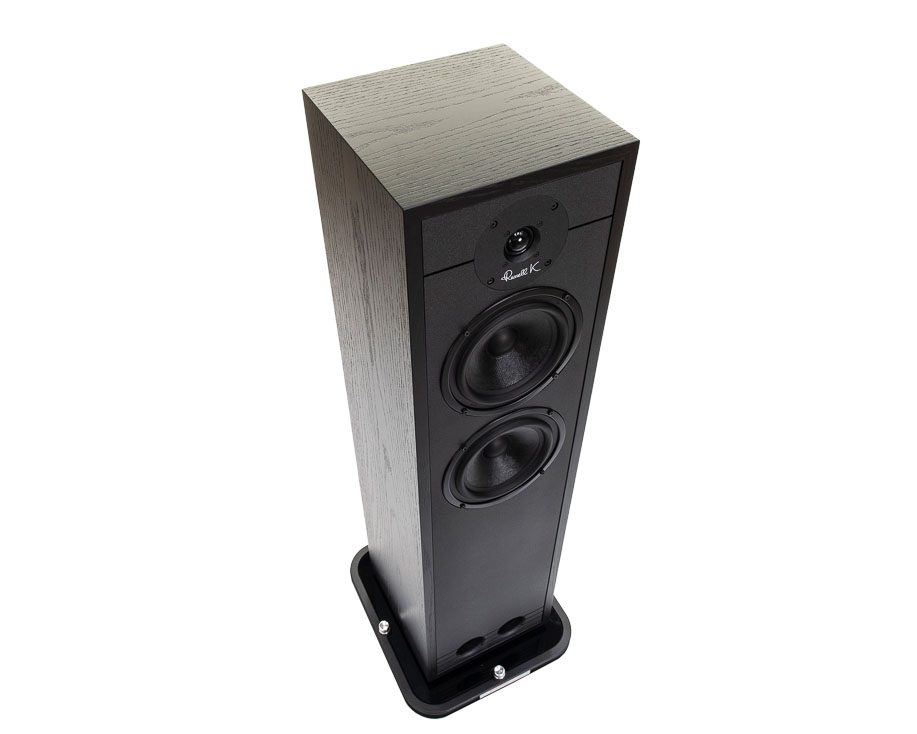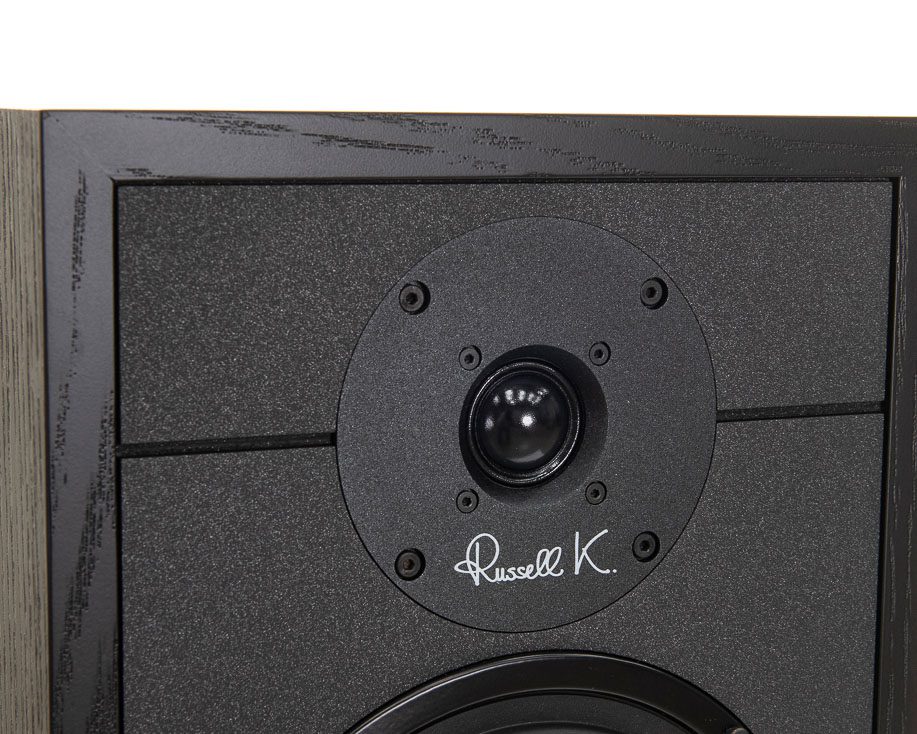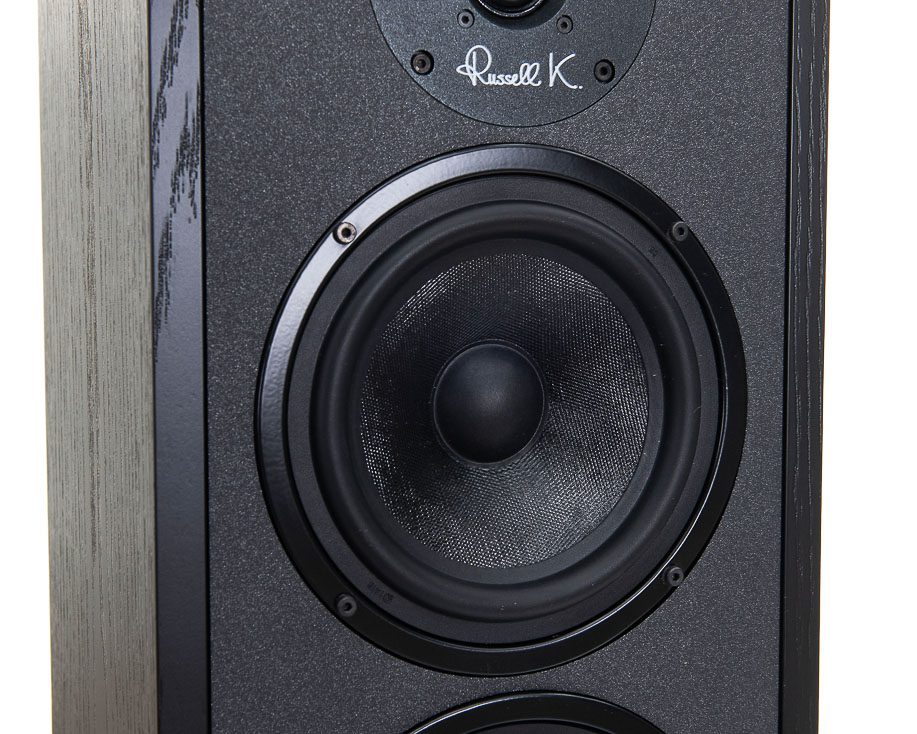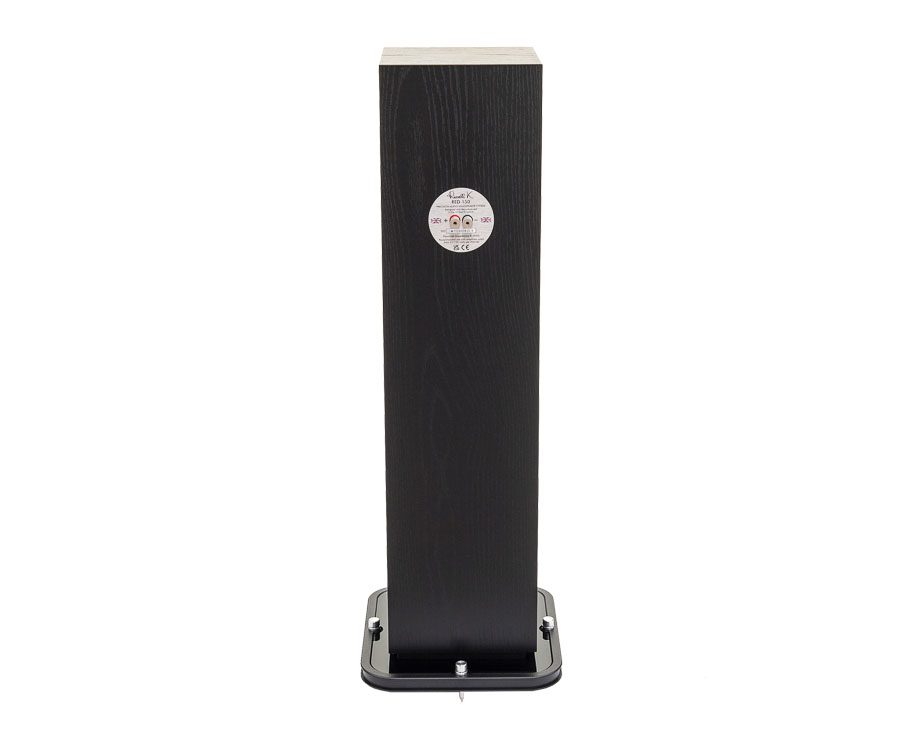
We reviewed the original Russell K. RED 150 here. The RED 150Se is a ‘breathed on’ version, introduced in 2019 and offering some significant improvements over the standard version.
The Russell K. range starts with the RED 50 bookshelf at £1,995, but the RED 150Se is the flagship model at £8,495, with the standard RED 150 below it at £6,795. I am very familiar with the RED 120Se in the range, and the RED 120Se and RED 150Se share the same tweeter, but the more substantial 150Se uses larger 165mm bass drivers.
Nice sounds all round
I heard these making some very nice sounds at a hi-fi show and they did not disappoint in my home system, producing an excellent performance at their price, all of which whetted my appetite to try the larger 150Se as soon as I could persuade the editor to play along. Which luckily he did, and so here I am with a pair of them in my listening room in a rather handsome piano white finish.
Russell K. itself arrived on the hi-fi scene relatively recently, in 2014, but founder and designer, Russell Kauffman traces his routes back further with considerable experience working for such top British loudspeaker names as B&W, Wharfedale, Monitor Audio and Morel.

During my initial chat with Kauffman about the speakers, he recalls how when he first started out, he wanted to design something that has a distinctive sound. He may not have had access to the kind of R&D budget of some of the big boys, but he used his ears as well as measurements to determine the final designs and during his time working for the big names, learnt many lessons, including which approaches and ideas he felt did not work, and these principles and learnings run through the entire range of Russell K. speakers from top to bottom.
The BBC legacy lives on
One key area is cabinet construction. He recalls BBC research which found that stored energy in rigid, heavy cabinets can cause coloration. Kauffman has found the same and so prefers to use thin-walled cabinet without lots of damping panels stuck to them and he controls cabinet flexure instead by using internal bracing shelves with multiple holes drilled in them – three of them in the RED 150Se, there’s one between tweeter and bass/mid driver, one between that and sub-bass driver and one situated below the sub-bass driver.

As well as the two reflex ports on the front panel, there is also a third, internal reflex port mounted on a fourth shelf, which vents into a small internal cavity and then through the twin ports, which are tuned to 21Hz.
The bracing shelves are also designed to drastically reduce midrange standing waves and make sure that no midrange energy makes its way out of the port tube and only bass escapes into the full volume of the enclosure. The shelves also mean he does not need to stuff the cabinets full of acoustic wool or BAF wadding in a bid to absorb reflections and standing waves. This too, he tells me, has helped to improve the sound of the speakers.
Kauffman tuned the bass/mid and sub-bass units to work together by adjusting the number of holes in the internal shelves. The system, he says, provides a strong braking effect around 100Hz, which helps provide the kind of tight, controlled bass normally associated with a good sealed box design.
The keen-eyed among you will spot that the two 50mm diameter ports on the front panel are not the same length, one is 50mm long and the other is 170mm. Kauffman confides to me that during development, when he would use a rolled-up brochure in the port to determine the ideal length and tuning, and discovered quite by chance the 150Se sounded better with one port longer than the other. He says he could measure no difference, but he believes it helps to control phase and in any case, it just sounded better. So he left it that way.
Simple, not simplistic
Another central tenet of his design philosophy is a simple crossover. He believes there is “a lot of rubbish talked about crossovers in the hi-fi industry”. He says that many assume that you connect a coil to a woofer and you get a 6dB/octave roll-off but, he says, in reality you don’t because of the natural roll-off of the driver itself. Many speakers have a separate circuit to control what the driver is doing, but that is not Kauffman’s way. He uses a nominal 12dB/octave circuit but the values of the components used are not text-book and are tuned to get the roll-off he wants, which, he adds, means that when the tweeter comes in, it is wired and playing in phase. This, he says, to his ears, gives the best sound and the values of components used were arrived at after listening to a combination of speech and music.

Kauffman also has another secret in his crossovers. He does not like air-cored or ferrite-cored inductors used in series with the bass and bass/mid drivers. Kauffman dislikes air-cores as you need more turns of wire to get the same inductance, so they have a higher DC resistance, which he believes has an adverse effect on an amplifier’s damping factor. He also dislikes ferrite cores as he says they radiate energy like an antenna, affecting the performance of other components on the circuit board. Kauffman’s solution is Enclosed Field Iron Cores inductors, which he says have very low DC resistance and don’t pollute the crossover with radiated energy.
He also makes a point of listening to all of his drivers outside the cabinet, in free air, fed with a full-range signal. This, he says, allows him to judge the qualities of each driver more accurately.
So how does the RED 150Se differ from the standard 150? First, it has a new, upgraded 25mm soft dome tweeter, with a ferrite magnet system with copper clad aluminium voice coil wire on a fibreglass former with Faraday distortion cancelling copper ring. It has a metal face plate instead of the plastic one used on the standard 150. It has a higher output level and so the crossover had to be tweaked slightly to achieve the best match with the bass/mid driver. It has a new, bigger 30mH coil in the crossover for the sub-bass unit. The other difference is that the RED 150Se gets a new plinth and spikes.
Apart from that, the other attributes of the 150 are unchanged. The cabinet is made from 16mm MDF with 19mm for the front baffle, and it is totally undamped with three internal bracing shelves to control internal standing waves. It also uses the same internal reflex port. The reflex system is tuned to 21Hz. The two 6.5in woofers have impregnated paper cones and a 25mm voice coil with aluminium former and Faraday distortion cancelling copper ring. The crossover for the tweeter includes a (deliberately) misaligned Zobel network for tweeter attenuation and frequency shaping, and each driver has only one component in the signal path.
An easy load
Sensitivity for the RED 150Se is 87dB and it is designed to present the amplifier with an easy load. I used an Audio Note Meishu Tonmeister for my listening. Eight watts of single-ended 300B valve power is enough for the 150Se, as I have used it to drive the RED 120Se very successfully, and they are 1dB less efficient.
My source components were an Audio Note TT3 turntable with PSU3 power supply and Arm2/Io1, feeding an S9 transformer, aided and abetted by the same company’s CDT Five CD transport and DAC5 Special.
I know my room well and generally I know the sweet spot that works best with most speakers, and having got great results using the 120Se 280mm from the back wall and 350mm from the side walls, that is where I put the 150Se to start with. I spent some time inching them around one way and the other, but on balance what worked for the 120Se also worked for the 150Se. As with the 120Se, the system of four spikes (each halfway along each side) allowed the cabinets to sit level and firm on my wooden floor.
Still crazy after all these years!
When you have been reviewing for as many years as I have, I have got to be honest and say that almost from the first few bars of music, you can tell if something is good, bad or indifferent, and so it was that the first few bars of ‘A Place for Skipper’ from guitarist Larry Carlton’s Discovery album put a broad grin on my face and had my foot tapping along to the beautiful, growly bass line from John Peña. Discovery was the second of two albums – the first was Alone But Never Alone – that caused quite a stir at the time among fans of the guitar wizard as they saw him playing all acoustic rather than the electric guitars for which he was famous. After all, the man is known as ‘Mr 335’ (Gibson ES335, that is). And we can hardly be surprised that this talent shines through just as well on acoustic as on electric, and the RED 150Se conveyed the easy lilt of this track beautifully and allowed me to hear every nuance of his play and how each note was shaped. Drums and percussion were similarly detailed and articulate and the whole track just grooved.

I then played ‘Hurts So Good’ from John Mellencamp and was impressed at the sheer impact of the drums. which were tight and dynamic, while Mellencamp’s vocals were full of emotion and grit, but without any harsh edges. The track flowed well and the bass line moved well and the track was musically engaging.
I then tried a beautiful 1968 recording from The Mose Allison Trio called Black Country Suite for Piano, Bass and Drum. This album, despite its age, is a lovely recording and has possibly one of the best drum and cymbal sounds I have heard. On the 150Se, cymbals were open, dynamic, detailed and really rang out, while Mose Allison’s beautifully fluid piano play was conveyed with all of its intricacies. The bass line too moved and kept the track moving along. I could not have asked for more from the 150Se, which took it all in its stride with an easy musicality.
Spinnng up Dave Koz’s Saxophonic on the CD player, the track ‘All I See Is You’ was masterfully handled with great body, bite and dynamics to Koz’s tenor sax, while drums had great snap and control and the bass line had great weight and tunefulness. The 150Se separated out the various threads of the track coherently and allowed each musician’s contribution to the whole to be plainly heard.
The 150Se’s ability to capture the musical integrity of a track also came over on ‘Didn’t It All Come True’ from Ben Sidran’s Bop City, where the sound was wonderfully dynamic and really motored along apace. Bass lines were deep and tuneful, drum beats were powerful and tight, while Sidran’s piano play was fluid and full of artistry and his vocals conveyed with their signature poise and swing.
Greatly impressed
By now you will have gathered that the Russell K. RED 150Se impressed me a great deal with their capabilities and I enjoyed listening to everything I played on them. They are musical, convey the rhythmic impetus and structures of the music well and combine those with an insight into the intricacies of what each musician is playing, so that the whole gels together into a musically captivating experience.

If you have around £8,500 burning a hole in your pocket and musical satisfaction is your desire, then you would do well not to overlook the RED 150Se. They are a class act.
Technical specifications
- Type: 2.5-way three-driver reflex-loaded floorstander
- Driver complement: 25mm soft some tweeter, 2 × 6.5in impregnated paper cone bass drivers
- Frequency response: 20Hz–22kHz
- Crossover frequency: 2.2kHz
- Impedance: 8 ohms
- Sensitivity: 87dB/1W/1m
- Dimensions (H×W×D): 950mm (1000mm including plinth/spikes) × 240mm × 250mm
- Weight” 28kg
- Finishes: Oak, Walnut and Black Oak, real wood veneers
- Price: £8,495 per pair
Manufacturer
Russell K.
+44(0)7831 481527
By Chris Frankland
More articles from this authorRead Next From Review
See all
PrimaLuna EVO 100 phono preamplifier
- Apr 22, 2024

Reiki Audio SuperSwitch Master Pro + Servant Pro
- Mar 27, 2024

Melco Audio N1-S38 music server
- Mar 27, 2024











